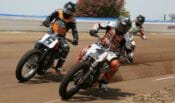Ducati’s SuperSport returns, better than ever
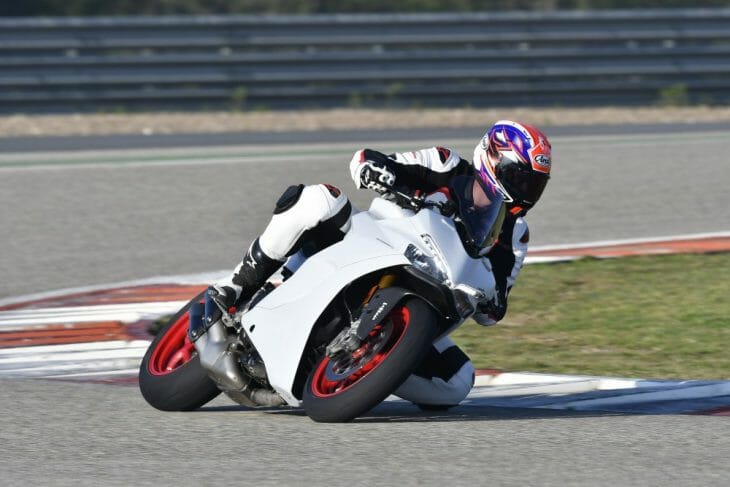
Sportbikes are specialized. They’re sharp as razors, designed for slashing lap times and shredding 200 section tires. But what if they didn’t need to be? What if you could have your cake and eat it, too?
Ducati seems to think you can and they’ve got the bike to prove it in the brand new Ducati SuperSport and SuperSport S.
Towards the end of last year, when the motorcycle press was collectively burning through their keyboards with all the new models that were released at the Intermot and EICMA shows in Cologne and Milan, respectively, Ducati dropped this little beauty on us.
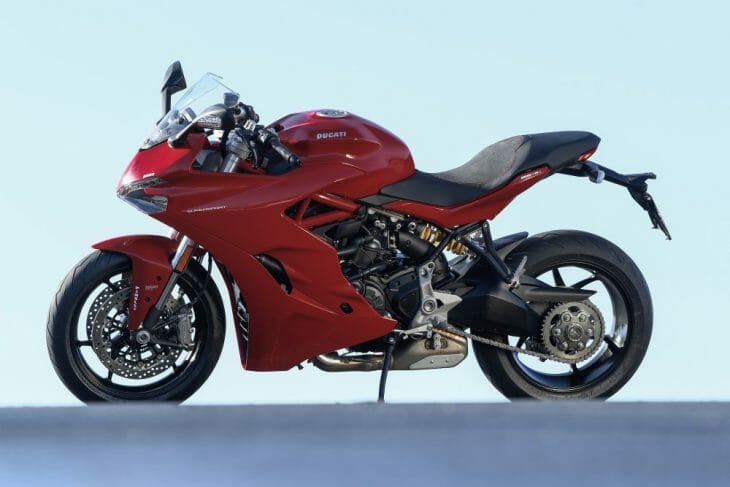
The Ducati SuperSport and SuperSport S signaled the return of one of the most revered names in the Ducati line up. The original model ran from 1987 to 2007 and sold like hotcakes across the world before eventually being put out to pasture, just as Ducati’s sportbikes became ever more focused and racetrack oriented (step forward, the 1098).
Return of the SuperSport legend
Now we have not only the name back but a totally new mindset from the Bologna boys. On the drawing board for two years and using a modified version of the 939 Hypermotard engine, the SuperSport and SuperSport S aims to bring back the fun, style and enjoyment of sportbike riding without the need to see 180mph on the dash. It’s a problem Ducati knows it played a part in creating with 200hp bikes like the Panigale or even the super-quick 959 Panigale, but they’re hardly alone in that regard.
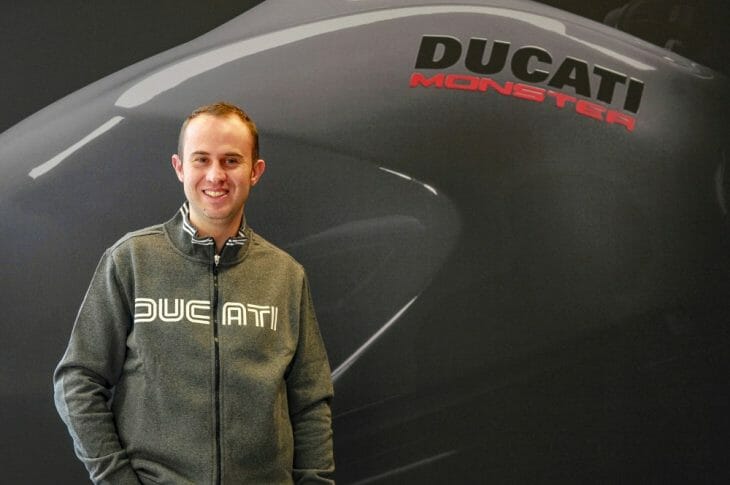
“It was the idea to use the Hypermotard engine because this engine has enough power for this kind of bike,” said the SuperSport’s Lead Project Engineer, Giuseppe Caprara. “The right torque is very important for this bike to have fun on the open road. Now, with a real superbike (like the Panigale), the power is not useable on the open road for the speed limit. So it was for us very important to have an engine with a great balance for the SuperSport. This was the right engine.”
All told, the new Hyper-derived desmo motor punches out 113 hp at 9000 rpm, with torque peaking at 71 lb-ft at 6500 rpm—80 percent of which is available at just 3000rpm—but it isn’t just bolted into the new SuperSport chassis, mind you. The SuperSport uses a similar style chassis to the Panigale in that it’s a monocoque with the engine used as a stressed member, so the Ducati engineers had to modify the cylinder head, crankcase, generator cover, the external coils, use 53mm throttle bodies versus the Hyper’s 52, and fit a new Ride-by-Wire throttle system developed in house with the fuel injection duties moved from Magneti Marelli to Continental.
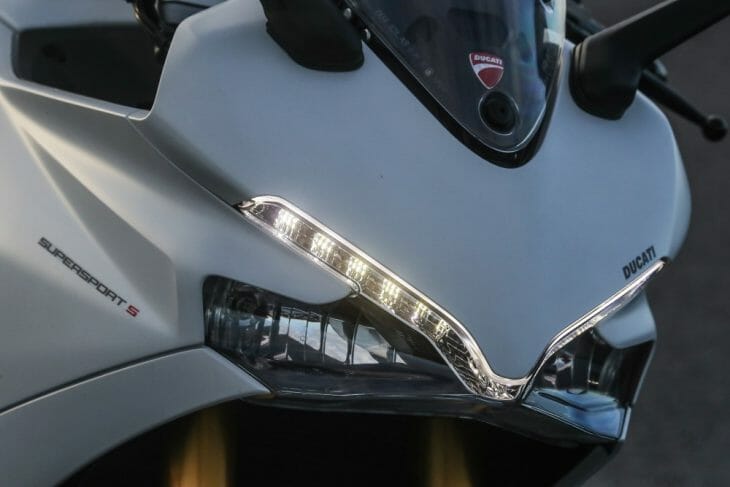
The gearbox also came in for a once over, considering it’s been fitted with the Ducati Quick Shift (DQS) as standard on the S model and an accessory on the base SuperSport.
“The gearbox is different because it’s stronger,” Capara says. “We work on the gears to make them stronger the for the quick shift. Quick shift is of course a fun device but is not fun for the gearbox! There’s a lot of stress. So in order to have the best reliability we want just to be sure that the gearbox was okay without this application.”
Same, but different
There’s no power or torque difference between the standard model and the S, but there is in terms of suspension. The base model uses fully adjustable 43mm Marzocchi forks and a Sachs shock with preload and rebound adjustment, while the S gets beefier 48mm fully-adjustable Öhlins forks and Öhlins shock out the back.
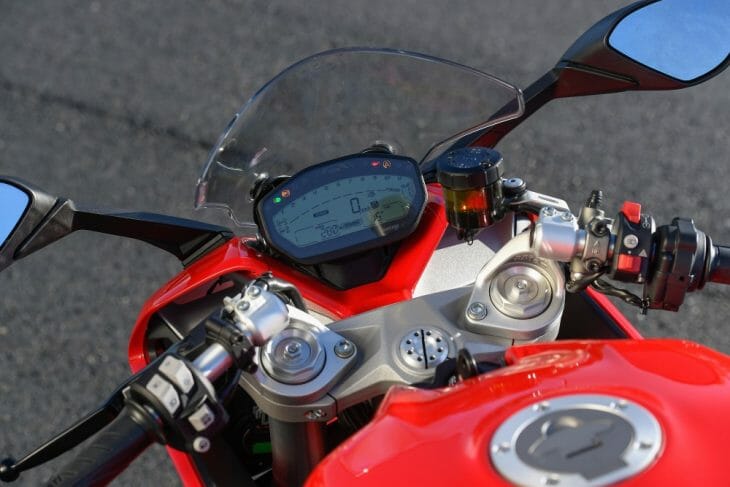
For the electronics, it’s the same across both the standard and the S models. Both machines come with three available engine maps (Sport, Touring and Urban), as well as switchable eight stage traction control and ABS. The cockpit itself draws hues from bikes like the Multistrada with similar switches on the right and left bars, although getting in and changing the settings on the dash takes a bit of time to get used to as it’s not the most intuitive of systems.
Everything else is pretty much the same between the two bikes, except for the S getting the aforementioned quick shifter as standard fitment, as well as a single seat cover. The bodywork is a case in point in that the designers wanted no visible screws or fasteners to give the cleanest look possible. That does mean taking the fairing off can be a challenge due to the hidden fasteners around the headlight and under the bars, but they certainly succeeded in making a visually stunning machine, so much so the SuperSport was voted most beautiful machine at EICMA in 2016.

Motoring around Monteblanco
The chance to sample the SuperSport S came at the stop/start 2.76-mile circuit of Monteblanco, located about a half hour’s drive west of Spain’s glorious, ancient city of Seville. We would also sample the base model SuperSport in the hills surrounding the circuit a little later in the afternoon—a ride that proved you didn’t need to fork out an extra two grand to enjoy the SuperSport life if you didn’t want to.
Part of the design ethos of the SuperSport S was that it had to be competent around a racetrack. After all, it is a Ducati with a fairing so racetrack ability has always been a priority, and the new SuperSport S delivers in spades. It’s a more sedate track experience due to not only the 113 hp motor but also the ride position. Ducati’s tall clip-on bars, mounted atop the top triple clamp rather than beneath, give close to a nakedbike riding position and allows the rider to really hustle the little Ducati around the racetrack. The seat is another interesting point for the track due to its curvature. It’s clearly designed for road use and on the track I had to move myself onto what would be the passenger seat to get a full tuck, but during cornering it holds the rider in place beautifully.
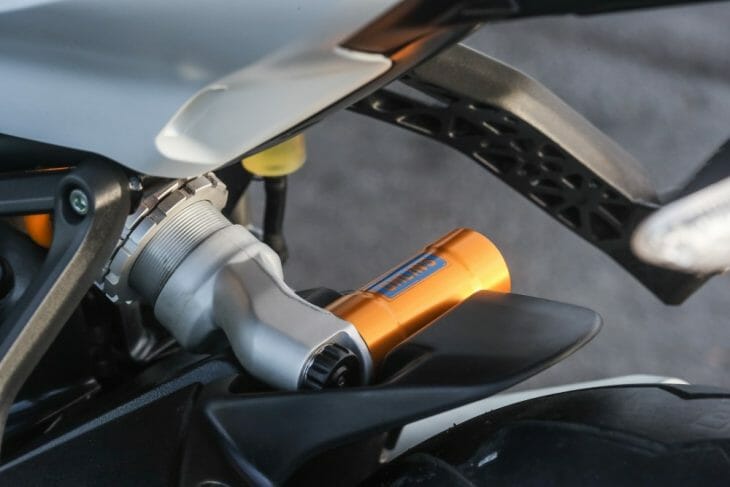
The Hypermotard-derived engine has lots of user friendly torque down low off Monteblanco’s many hairpins, but not so much that you’d use something like third gear instead of second. It fair rushes up the rev range and produces quality horsepower right until you hit the soft-action limiter at 10,500rpm. I found it was better to shift about 500-1000rpm earlier to get the most out of the engine, but a couple of lazy moments where I hit the limiter didn’t prove too nut-cracking, as on many other bikes.
You must be deliberate in your gearshifts because a light shift will see you cut the ignition without selecting your desired gear. The quickshift is a little touchy but as long as you make your shifts with authority you’ll never miss a gear.
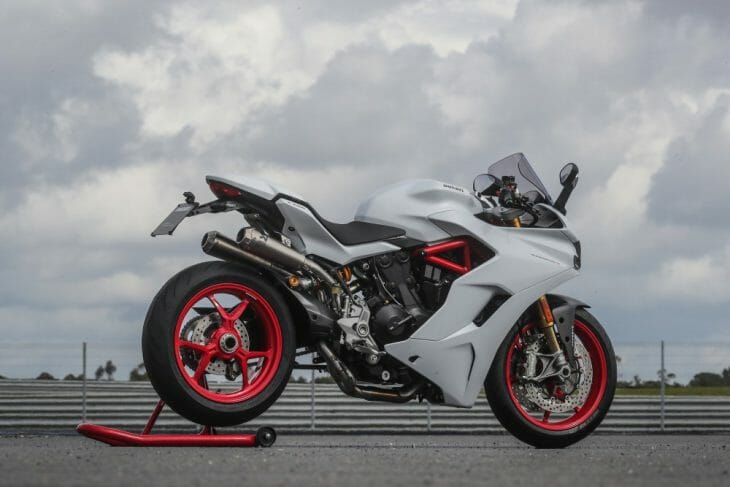
You’ve got eight stages of traction control with the SuperSport, and combined with the road compound Pirelli Diablo Rosso III rubber you’ll start seeing the yellow TC light flickering on the dash pretty quickly in anything from level three up. The TC cut itself is smooth—it still allows you to drive forward under power—but you can tell the system is holding you and the bike back. Lowering the TC level gives a bit more control back to the rider, and when I found myself in level one, the SuperSport was a sheer joy to ride with a bit more mechanical feedback coming from a rear Pirelli allowed to do its thing rather than being held on the electronic bungee-cord.
As for the chassis, the SuperSport S is an absolute peach. Those 48mm Öhlins fork and shock do a superb job of keeping everything in line and providing good braking and acceleration support. Mid-corner through Monteblaco’s flat out right hand turn five saw the S solid as a rock, equally as good as the dead-stop left of turn 15.
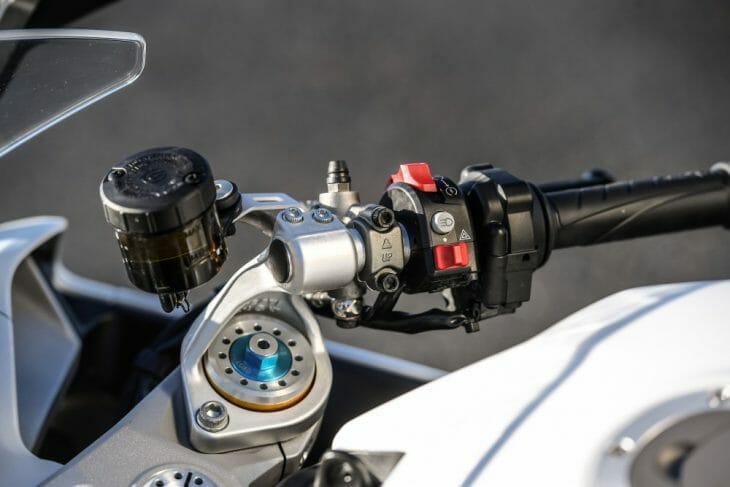
The Brembo M4.32 brakes are exceptionally good, with plenty of power and feel. It’s a similar story with the ABS system as it is with the TC in that dialing the system back somewhat allowed for more mechanical feel at the lever and thus a bit more power, which was useful at the end of the 240km/h straight!
Even better on road
Switching to the base model for the road component however really highlighted the strong points of the SuperSport. This is where the bike is at its most comfortable. The engine’s 113hp is ideally suited to the kind of riding most of us do—there’s plenty to keep you interested—but it’s not scare-you-stiff levels of go, like something you’d get from a Panigale.
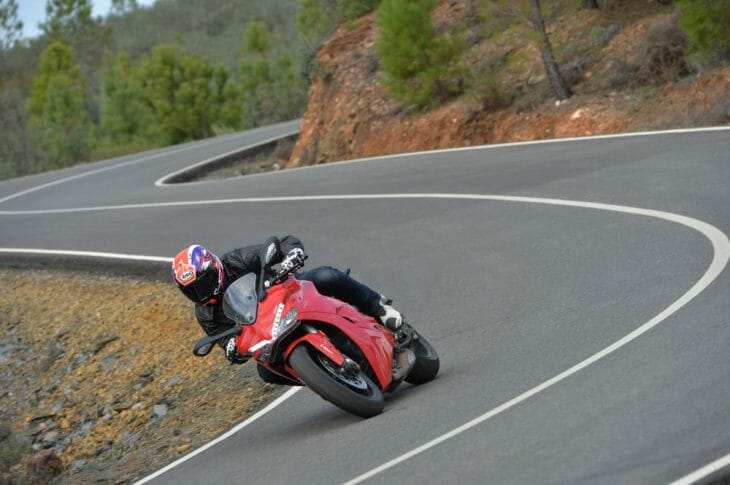
After three sessions with the SuperSport S in Sport mode on the track it surprised me more than any to realize I spent the majority of the road ride in Touring mode. The slightly softer power delivery gave me a somewhat easier time, especially in some of the really tight villages we cruised through. That’s not to say Sport isn’t okay for the road, it’s just that the Touring throttle map is that little bit more enjoyable.
The base model’s Marzocchi forks and Sachs shock at no point had me wanting the extra bling of gold Öhlins on the road. The action from the less expensive suspension is no less impressive on the street, simply because the slightly more compliant settings made for a smoother ride that what I’d get from the stiffer Öhlins. I’m sure I’d trade the Marzocchi’s for Öhlins in a second once I got to the track, but for road use I had no issues at all.

Everything that’s great about the bike on track shines through on the road. The power is unintimidating but more than enough, and the chassis loves hunting apexes on mountain roads.
It’s comfortable, too. The seat mightn’t be the ideal unit for the track but for the road, Ducati may have just struck the best compromise in real-world comfort and sporting capability for a faired bike. The curve of the seat angles the rider just forward from bolt upright, and the high-placed clip-on bars make for a supremely comfortable riding position. Eighty-five miles isn’t much of a ride but I could have knocked out another two of them before I started to get tired and sore.
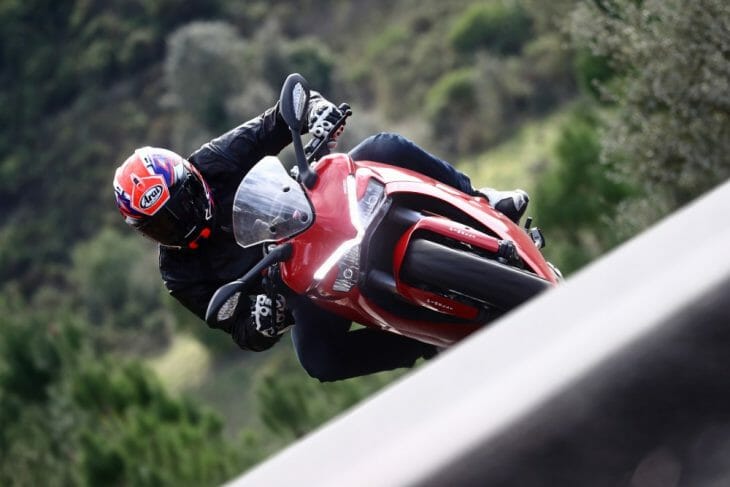
Sportbike for the people
After a short road ride and three track sessions, the SuperSport is, in my opinion, the sportbike we’ve been missing. It’s more sport than touring and I’d sooner have one of these than a 959 Panigale any day if my riding consisted of commuting, canyon scratching and a couple of trackdays per year. It’s more comfortable, it’s got a good little engine on it, has the looks with that ultra-cool daytime running light and Panigale-esque design, and the electronics are smooth in their application, although I’d have liked a slightly more intuitive dash.
The SuperSport and SuperSport S are highly impressive machines.
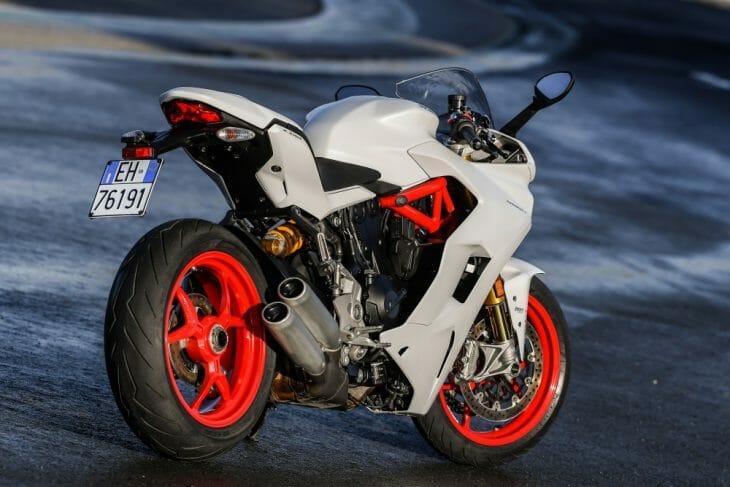
Specifications
2017 Ducati SuperSport and SuperSport S
Engine: Testastretta 11°, L-Twin cylinder, 8 valve, Desmodromic, liquid cooled
Displacement: 937cc
Bore x stroke: 94 x 67.5 mm
Horsepower: 113 hp @ 9000 rpm (claimed)
Torque: 71.3 lb-ft @ 6500 rpm (claimed)
Compression ratio: 12.6:1 (± 0.5:1)
Fuel system: Continental electronic fuel injection system, 53 mm Mikuni throttle bodies with full Ride-by-Wire. 3 throttle modes.
Exhaust: Two into 1 into two
Transmission: Six-speed gearbox. Quickshifter-equipped on S model.
Chassis: Tubular steel Trellis frame attached to the cylinder heads
Front suspension 41mm Marzocchi forks, fully adjustable (base model); 48mm Ohlins fork, fully adjustable (S model). 5.12 in wheel travel (both models)
Rear suspension: Progressive linkage with rebound and preload adjustable Sachs monoshock. Aluminum single-sided swingarm (base model); Progressive linkage with fully adjustable Öhlins monoshock. Aluminum single-sided swingarm. 5.67 in wheel travel (both machines)
Front brake: Twin 320 mm semi-floating discs, radially mounted Monobloc Brembo M4-32 calipers, four-piston, radial pump with ABS as standard
Rear brake: Single 245 mm disc, two-piston caliper, ABS as standard
Front tire: Pirelli Diablo Rosso III 120/70 ZR17
Rear tire: Pirelli Diablo Rosso III 180/55 ZR17
Rake: 24°
Trail: 3.6 in
Wheelbase: 58.2 in
Seat height: 32.1 in
Fuel capacity: 4.2 gal
Weight: 463 (curb, claimed).
Color: Ducati Red and Saturn Grey, Ducati Red and Star White Silk (S model)
MSRP: MSRP $12,995 ($14,795 for S)
Click here for more Cycle News Sport Bike motorcycle reviews.
Click here for more Ducati motorcycle reviews.
